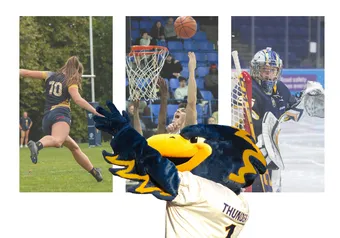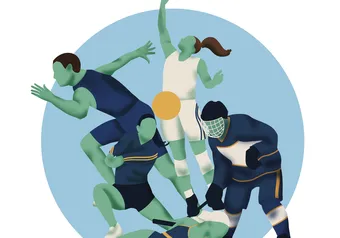Behind the names of most university sports teams normally lies a story — some are more compelling than others.
The Thunderbirds are one such team.
McGill University decided to call their men’s teams the “Redmen” as a result of their athletes wearing red sweaters and, allegedly, because of school founder James McGill’s hair colour — but it is widely considered racist towards Indigenous peoples. In the case of UBC’s “Thunderbird” and its origin, the story is also a hair-raiser.
The process for naming the school’s sports teams began in 1933. At the time, other universities had already devised names for their teams while UBC athletes still competed under the titles of “varsity” and “Blue and Gold.” UBC wasn’t so much looking to rename its teams, but was looking to legitimize its team beyond jersey colour.
This is where The Ubyssey comes in. According to UBC sports historian Fred Hume, the newspaper decided to use the ever-popular student vote to determine the school’s new team name in fall 1933.
It started with an article. As AMS Archivist Sheldon Goldfarb states in his article “How the Thunderbird Came to UBC,” The Ubyssey released an article entitled “Zoological Cognomen Needed for Our Athletic Teams” that urged students to submit potential names for varsity athletics. The most popular suggestions would end up on the ballot for a student vote.
The article didn’t elicit much response, so The Ubyssey released another article — presumably with less polysyllabic words — and the students came out in droves.
Ultimately, Spartans, Corsairs, Thunderbirds, Golden Eagles and Musqueams were the five most popular suggestions. All of them were put to vote. There was also a write-in option on the ballot and, if you are familiar with the nature of student voting, it shouldn’t come as a surprise as that the new name for UBC’s athletic teams would be the Seagulls — a write-in candidate.
This wasn’t going to fly. The Ubyssey promptly dropped the idea of letting students choose the name of the school’s athletics teams. Instead, they decided to hold a meeting with the school’s Pep Club to collectively choose from one of the five original suggestions.
On January 31, 1934 — after hours of what Hume described as “lengthy and spirited debate” — the Thunderbird was finally chosen as the winner. The name was ratified on February 19, 1934.
One of the biggest lobbyists for the name was Clarence Idyll, a member of the sports department at The Ubyssey. Idyll sent a letter to the editor indicating that Thunderbird should be used because of its connection to Indigenous culture. He also continued to push for the name at the selection meeting — without his efforts, UBC’s sports teams would have never been called the Thunderbirds. In fact, the university wasn’t permitted to use the name Thunderbird until 1948, after Chief William Scow of the Kwikwasut’inuxw Haxwa’mis First Nation gave permission during a formal ceremony held at half-time of a football game between UBC and the College of Idaho.
Although many other sport teams tried to claim the Thunderbird title, Hume confirmed that UBC was the only one given permission by local Musqueam Indigenous communities to use the name. The term Thunderbird contains great meaning in many Indigenous cultures as the creature is seen as an underlying force that is responsible for all natural activity.
Hume added that UBC not only received permission to use the name at the Homecoming football game, but also received a totem pole named “Victory Through Honour” that was hand-crafted by carvers Ellen and Ted Neel from Alert Bay. This totem stood in front of Brock Hall before it was taken down in the early 2000s.
Efforts to replace the totem have since succeeded — in 2004, a replica was placed outside of Brock Hall, where it stands to this day.
All of this seems hard to imagine today, given that the Thunderbird logo is as common on campus nowadays as books and backpacks. But, despite the many changes to student life over the years, UBC students have always had a history of turning an otherwise-mundane event into something worth remembering.
Share this article
First online





